Abstract
Six pigeons were trained on concurrent variable-interval schedules. Two different reinforcer durations were arranged on the left key, and which of these was delivered was determined probabilistically. A single reinforcer duration was arranged on the right key. In Parts 1 and 3 of the experiment, the probability of the left-key reinforcer durations (1 and 7 seconds in Part 1; 3 and 10 seconds in Part 3) was varied from 0 to 1, keeping the schedules constant and the right-key reinforcer at 3 seconds. Response allocation to the left key fell as the probability of the shorter left-key reinforcer duration was increased. In Part 2, one left-key reinforcer duration was 3 seconds and the other was varied from 0 to 10 seconds, while again the schedules and right-key reinforcer duration (3 seconds) were kept constant. Left-key response allocation increased as the varied reinforcer duration on the left key increased. An extension of the generalized matching law failed to provide a good description of response allocation in these procedures. In Part 4, the left- and right-key reinforcer durations were 3 seconds and the variable-interval schedules were varied. Response allocation was well described by the generalized matching law. Part 5 arranged equal variable-interval schedules on the left and right keys, 3-second reinforcers on the right key, and the left-key reinforcer durations were varied from 1 to 10 seconds. The relationship between the log response and reinforcer-duration ratios was nonlinear. The effects of varying reinforcer durations in concurrent schedules cannot be described using the generalized matching law with constant parameters. It is suggested more generally that this quantitative relation may not describe performance either when reinforcing situations differ in duration (e.g., with delayed reinforcers) or when response requirements differ in duration.
Keywords: concurrent schedules, variable-interval schedules, reinforcer rate, reinforcer duration, generalized matching, sensitivity, key peck, pigeons
Full text
PDF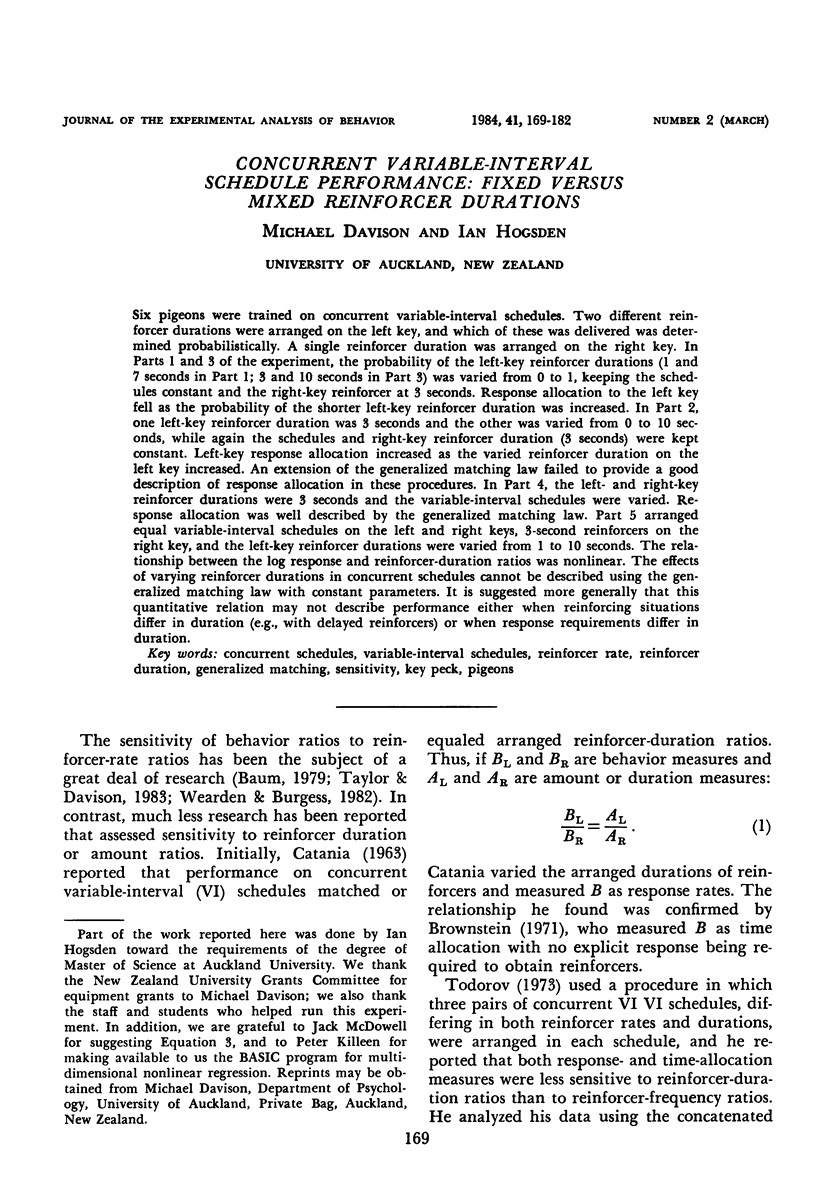
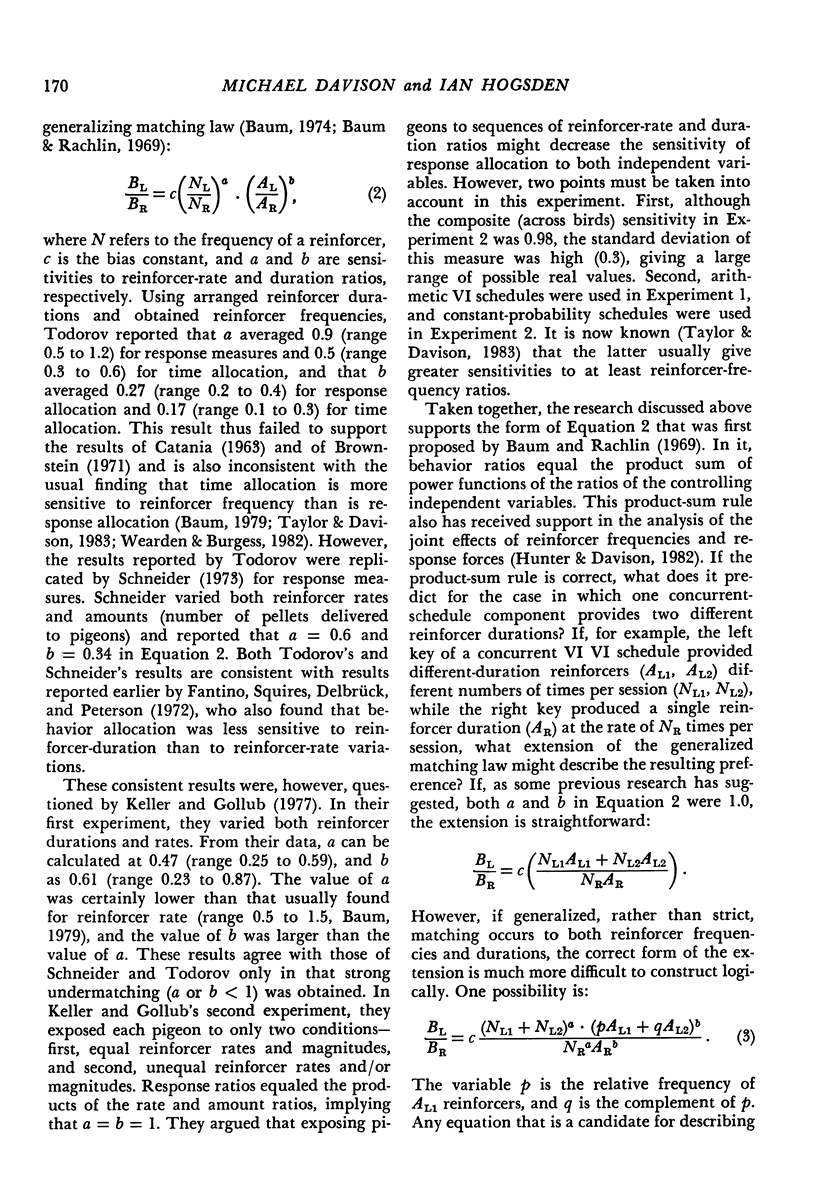
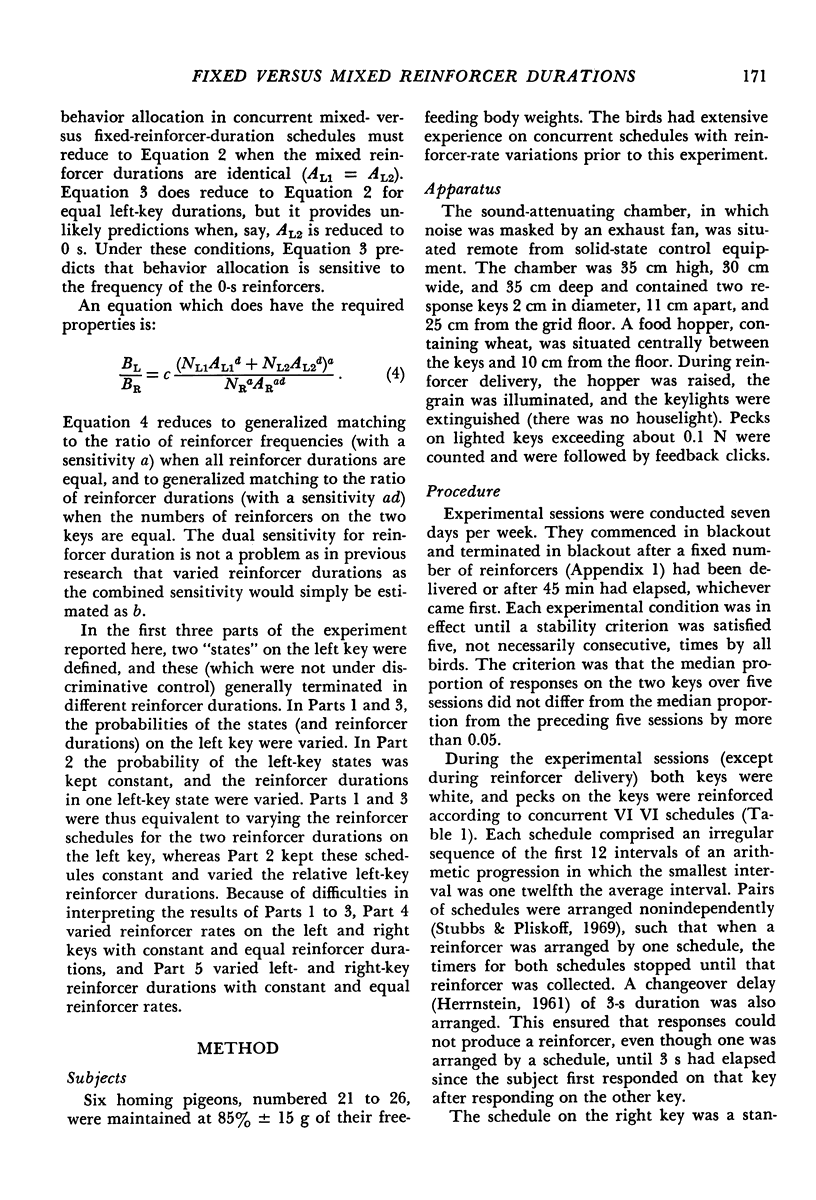
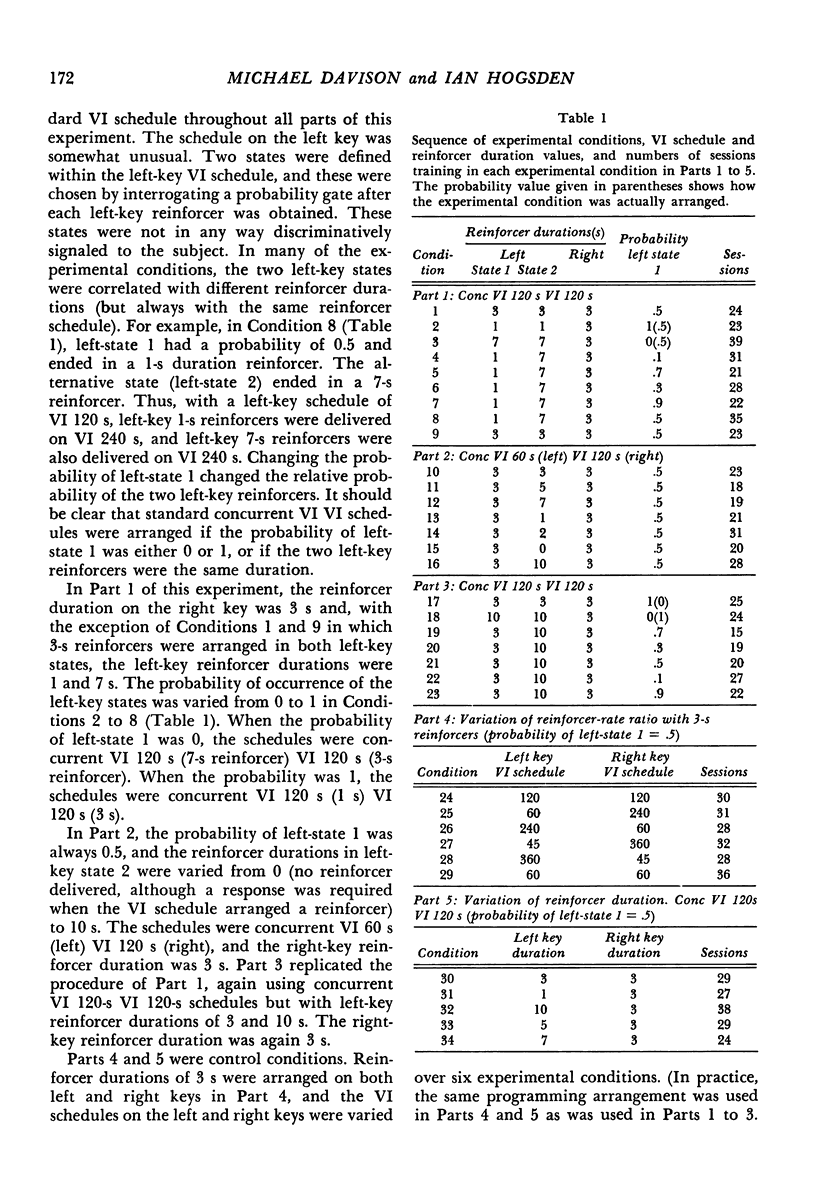

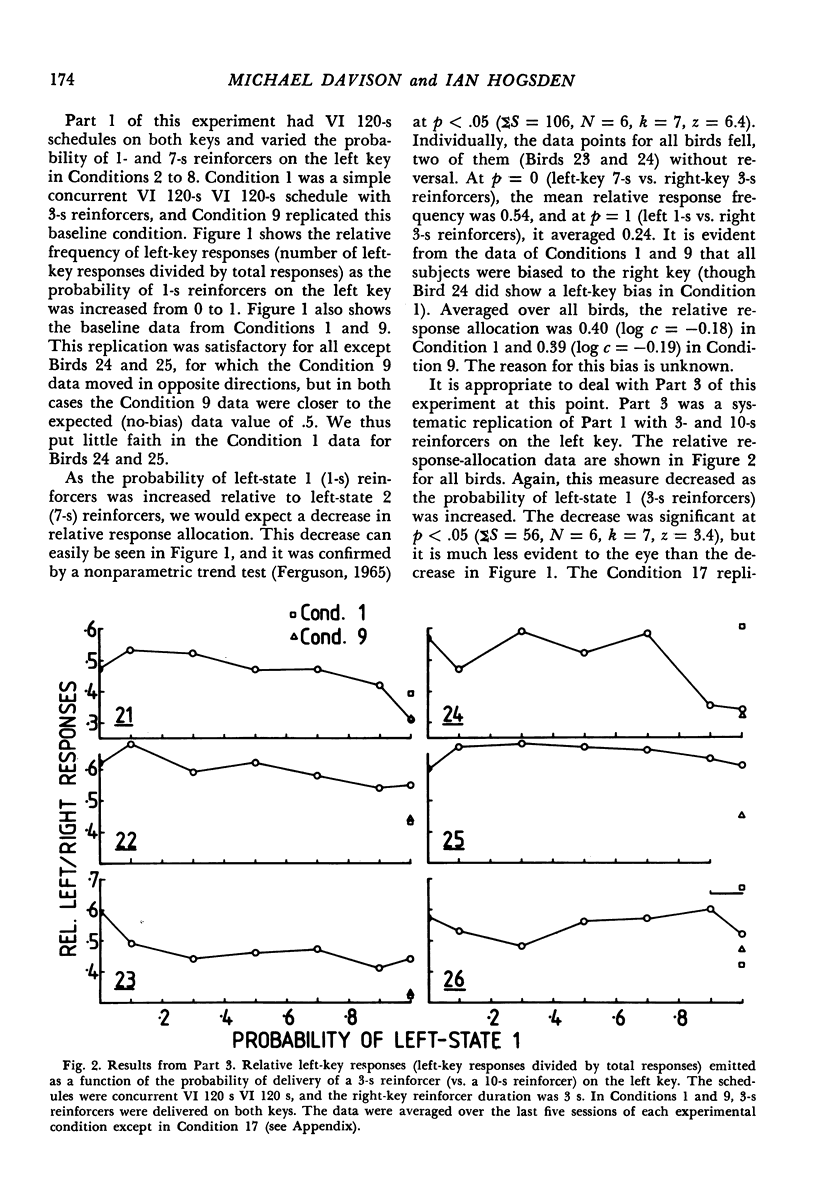


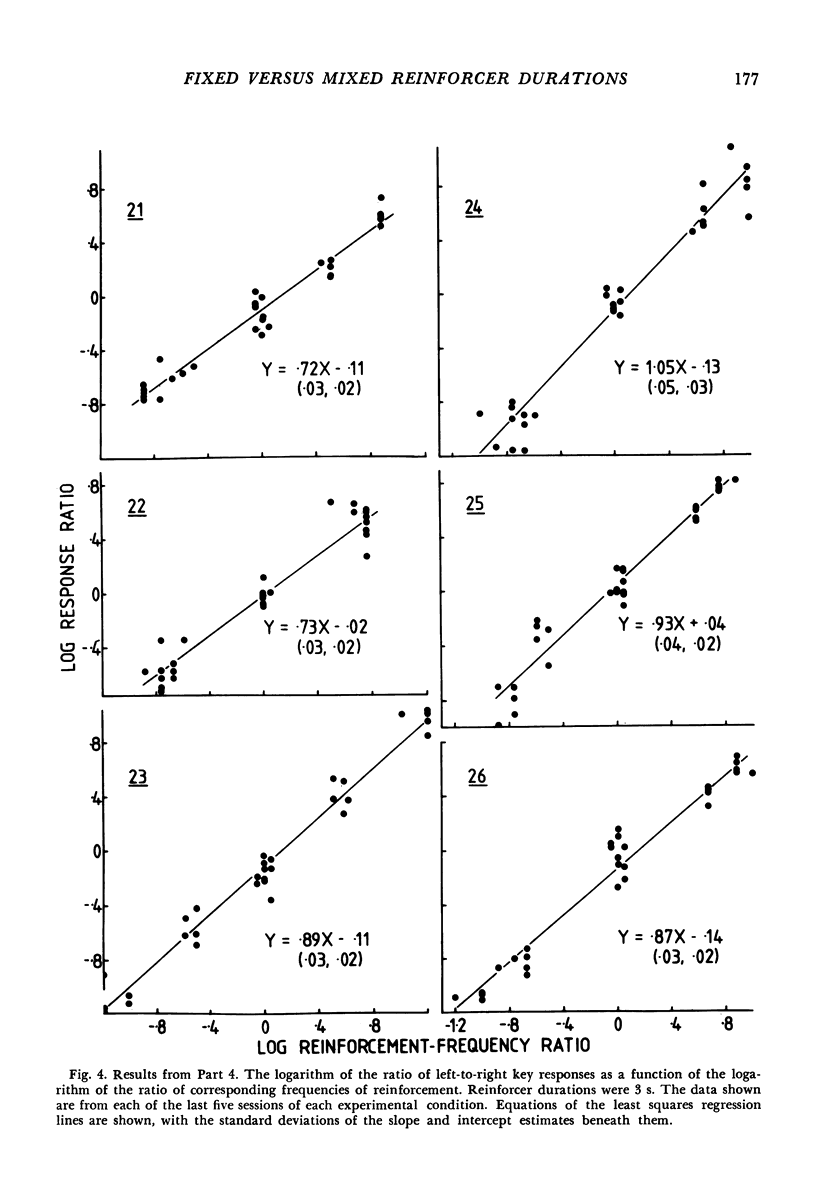
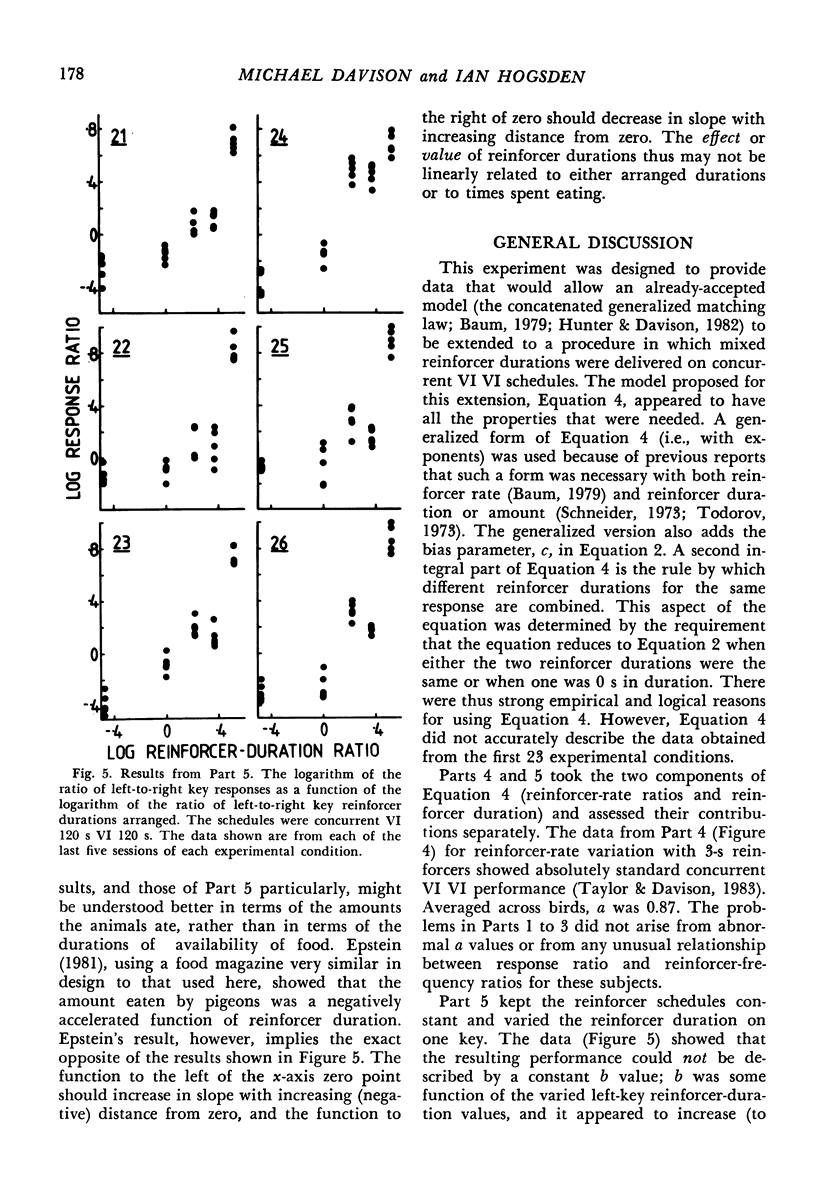
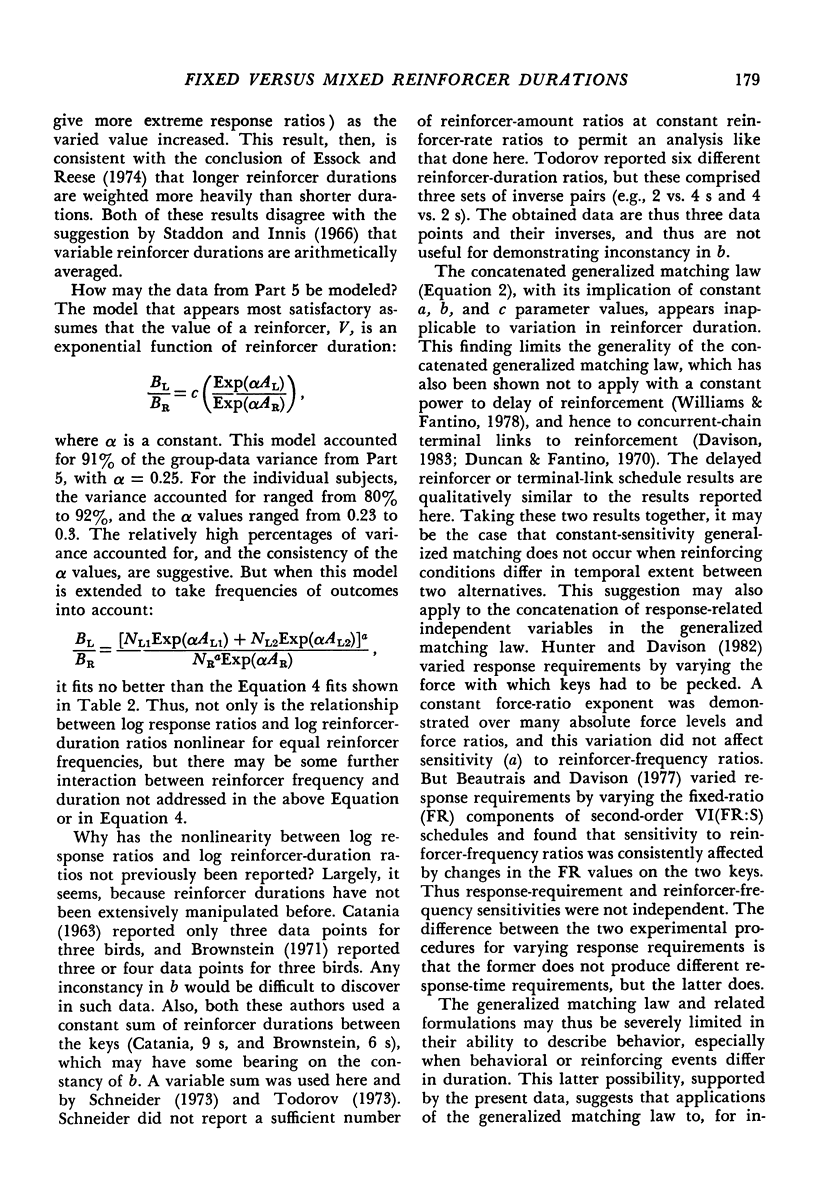
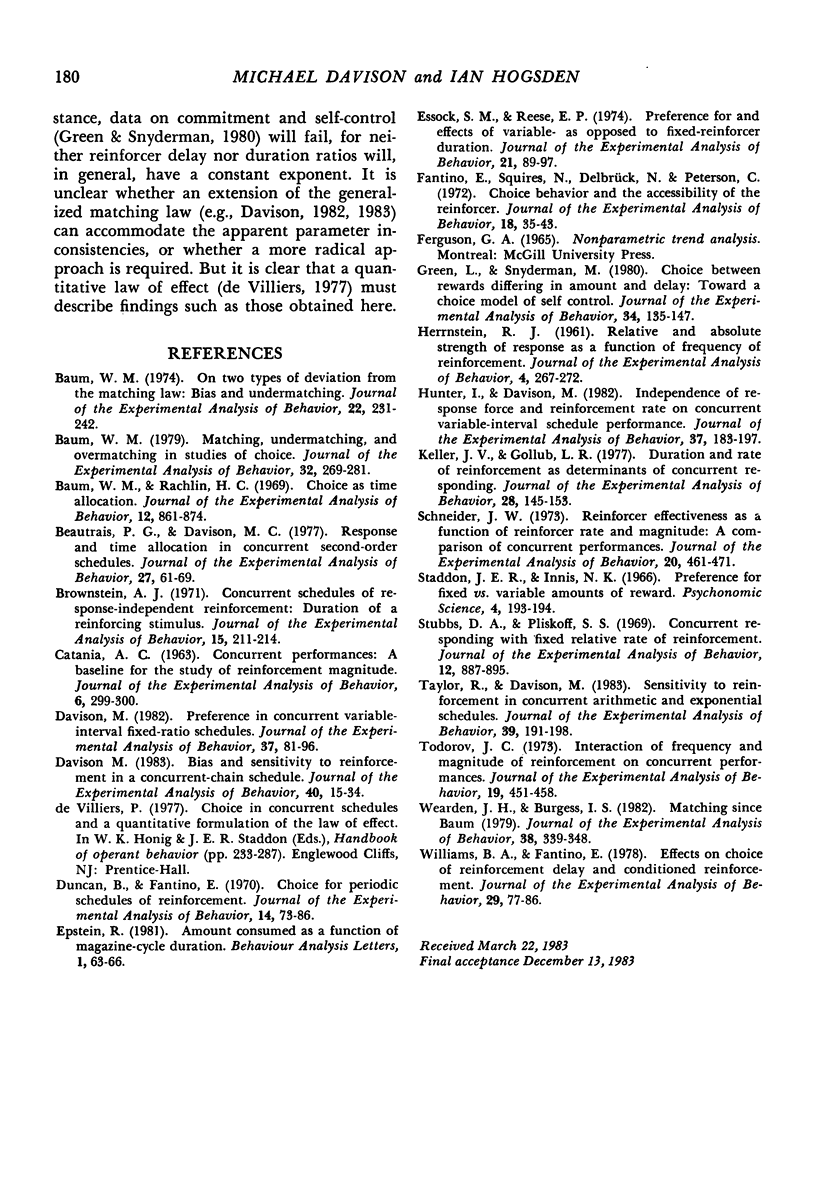
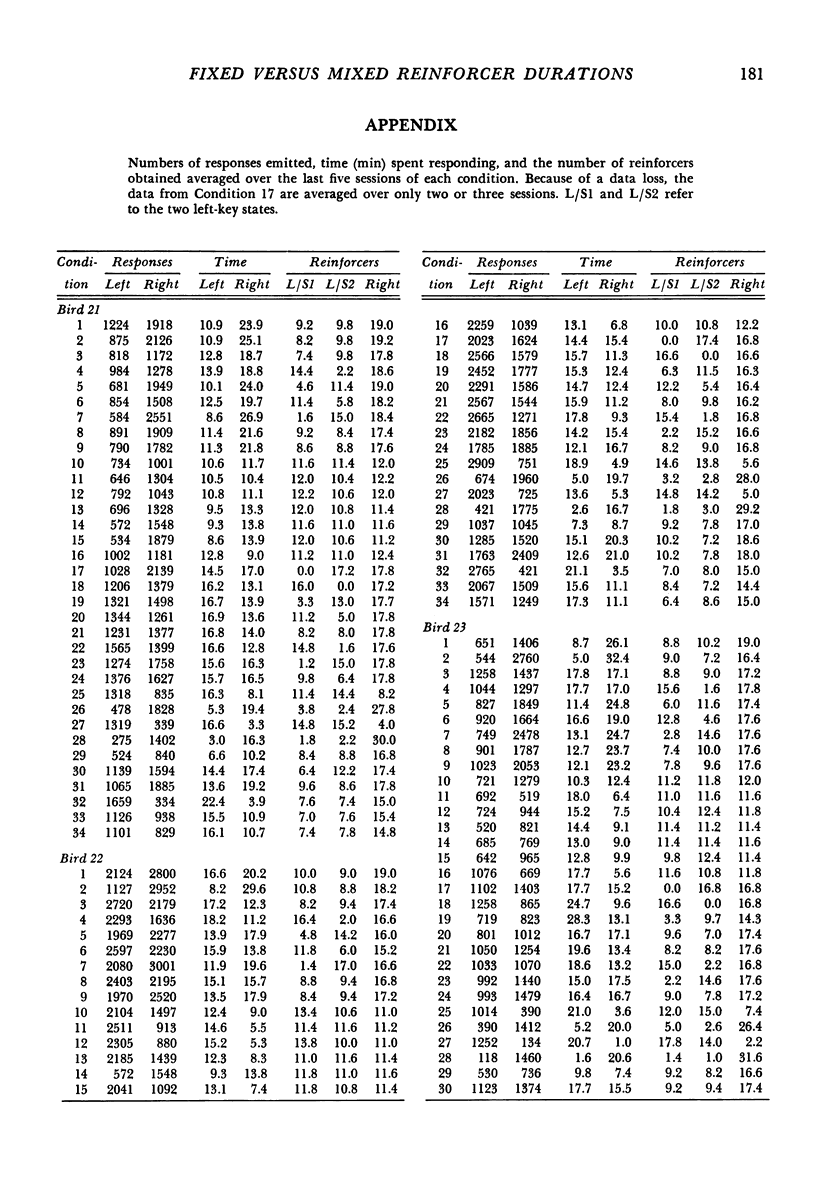
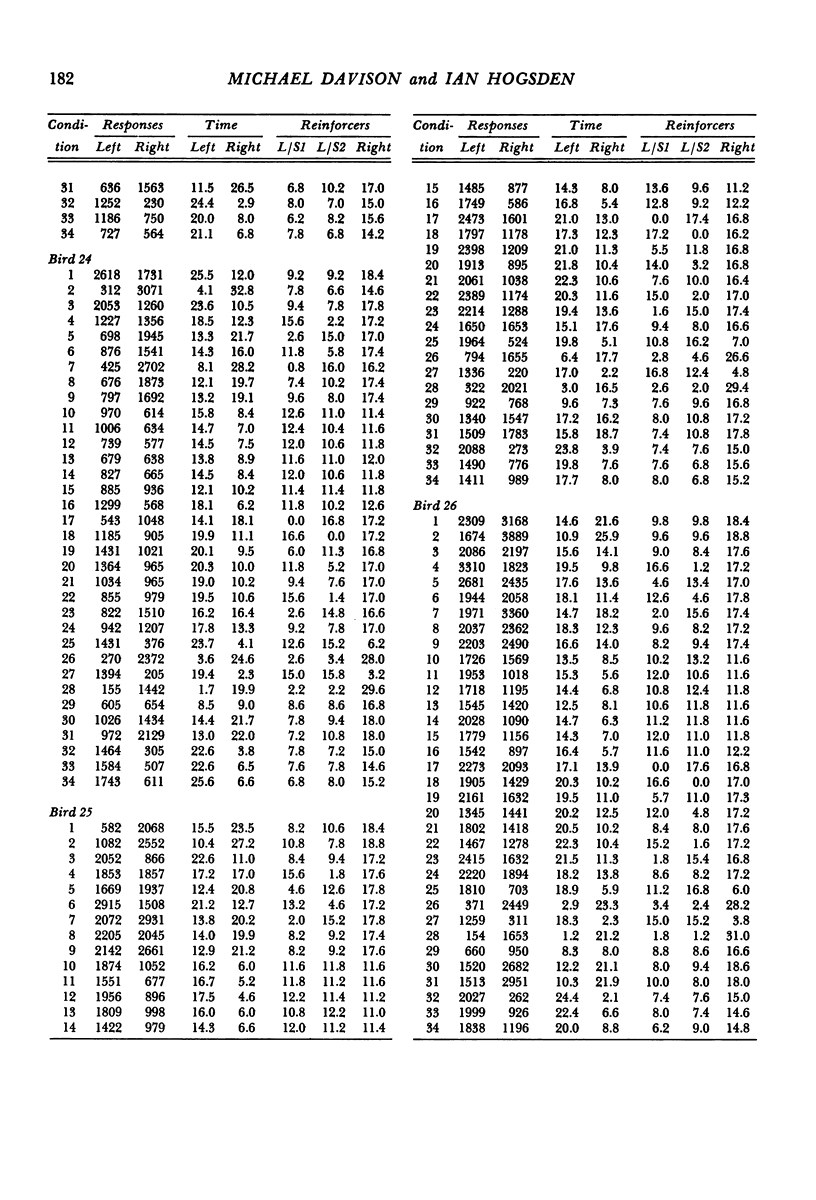
Selected References
These references are in PubMed. This may not be the complete list of references from this article.
- Baum W. M. Matching, undermatching, and overmatching in studies of choice. J Exp Anal Behav. 1979 Sep;32(2):269–281. doi: 10.1901/jeab.1979.32-269. [DOI] [PMC free article] [PubMed] [Google Scholar]
- Baum W. M. On two types of deviation from the matching law: bias and undermatching. J Exp Anal Behav. 1974 Jul;22(1):231–242. doi: 10.1901/jeab.1974.22-231. [DOI] [PMC free article] [PubMed] [Google Scholar]
- Baum W. M., Rachlin H. C. Choice as time allocation. J Exp Anal Behav. 1969 Nov;12(6):861–874. doi: 10.1901/jeab.1969.12-861. [DOI] [PMC free article] [PubMed] [Google Scholar]
- Beautrais P. G., Davison M. C. Response and time allocation in concurrent second-order schedules. J Exp Anal Behav. 1977 Jan;27(1):61–69. doi: 10.1901/jeab.1977.27-61. [DOI] [PMC free article] [PubMed] [Google Scholar]
- Bird T. P., Black W. A., Colquhoun J. A., Dewar E. T., Rutherford D. Preparation and derivatives of poly-(6-O-methacryloyl-D-galactose) and poly-(6-O-acryloyl-D-galactose). J Chem Soc Perkin 1. 1966;21:1913–1918. doi: 10.1039/j39660001913. [DOI] [PubMed] [Google Scholar]
- Brownstein A. J. Concurrent schedules of response-independent reinforcement: duration of a reinforcing stimulus. J Exp Anal Behav. 1971 Mar;15(2):211–214. doi: 10.1901/jeab.1971.15-211. [DOI] [PMC free article] [PubMed] [Google Scholar]
- CATANIA A. C. Concurrent performances: a baseline for the study of reinforcement magnitude. J Exp Anal Behav. 1963 Apr;6:299–300. doi: 10.1901/jeab.1963.6-299. [DOI] [PMC free article] [PubMed] [Google Scholar]
- Davison M. Bias and sensitivity to reinforcement in a concurrent-chain schedule. J Exp Anal Behav. 1983 Jul;40(1):15–34. doi: 10.1901/jeab.1983.40-15. [DOI] [PMC free article] [PubMed] [Google Scholar]
- Davison M. Preference in concurrent variable-interval fixed-ratio schedules. J Exp Anal Behav. 1982 Jan;37(1):81–96. doi: 10.1901/jeab.1982.37-81. [DOI] [PMC free article] [PubMed] [Google Scholar]
- Duncan B., Fantino E. Choice for periodic schedules of reinforcement. J Exp Anal Behav. 1970 Jul;14(1):73–86. doi: 10.1901/jeab.1970.14-73. [DOI] [PMC free article] [PubMed] [Google Scholar]
- Essock S. M., Reese E. P. Preference for and effects of variable-as opposed to fixed-reinforcer duration. J Exp Anal Behav. 1974 Jan;21(1):89–97. doi: 10.1901/jeab.1974.21-89. [DOI] [PMC free article] [PubMed] [Google Scholar]
- Fantino E., Squires N., Delbrück N., Peterson C. Choice behavior and the accessibility of the reinforcer. J Exp Anal Behav. 1972 Jul;18(1):35–43. doi: 10.1901/jeab.1972.18-35. [DOI] [PMC free article] [PubMed] [Google Scholar]
- Green L., Snyderman M. Choice between rewards differing in amount and delay: Toward a choice model of self control. J Exp Anal Behav. 1980 Sep;34(2):135–147. doi: 10.1901/jeab.1980.34-135. [DOI] [PMC free article] [PubMed] [Google Scholar]
- HERRNSTEIN R. J. Relative and absolute strength of response as a function of frequency of reinforcement. J Exp Anal Behav. 1961 Jul;4:267–272. doi: 10.1901/jeab.1961.4-267. [DOI] [PMC free article] [PubMed] [Google Scholar]
- Hunter I., Davison M. Independence of response force and reinforcement rate on concurrent variable-interval schedule performance. J Exp Anal Behav. 1982 Mar;37(2):183–197. doi: 10.1901/jeab.1982.37-183. [DOI] [PMC free article] [PubMed] [Google Scholar]
- Keller J. V., Gollub L. R. Duration and rate of reinforcement as determinants of concurrent responding. J Exp Anal Behav. 1977 Sep;28(2):145–153. doi: 10.1901/jeab.1977.28-145. [DOI] [PMC free article] [PubMed] [Google Scholar]
- Schneider J. W. Reinforcer effectiveness as a function of reinforcer rate and magnitude: a comparison of concurrent performances. J Exp Anal Behav. 1973 Nov;20(3):461–471. doi: 10.1901/jeab.1973.20-461. [DOI] [PMC free article] [PubMed] [Google Scholar]
- Stubbs D. A., Pliskoff S. S. Concurrent responding with fixed relative rate of reinforcement. J Exp Anal Behav. 1969 Nov;12(6):887–895. doi: 10.1901/jeab.1969.12-887. [DOI] [PMC free article] [PubMed] [Google Scholar]
- Taylor R., Davison M. Sensitivity to reinforcement in concurrent arithmetic and exponential schedules. J Exp Anal Behav. 1983 Jan;39(1):191–198. doi: 10.1901/jeab.1983.39-191. [DOI] [PMC free article] [PubMed] [Google Scholar]
- Todorov J. C. Interaction of frequency and magnitude of reinforcement on concurrent performances. J Exp Anal Behav. 1973 May;19(3):451–458. doi: 10.1901/jeab.1973.19-451. [DOI] [PMC free article] [PubMed] [Google Scholar]
- Wearden J. H., Burgess I. S. Matching since Baum (1979). J Exp Anal Behav. 1982 Nov;38(3):339–348. doi: 10.1901/jeab.1982.38-339. [DOI] [PMC free article] [PubMed] [Google Scholar]
- Williams B. A., Fantino E. Effects on choice of reinforcement delay and conditioned reinforcement. J Exp Anal Behav. 1978 Jan;29(1):77–86. doi: 10.1901/jeab.1978.29-77. [DOI] [PMC free article] [PubMed] [Google Scholar]


